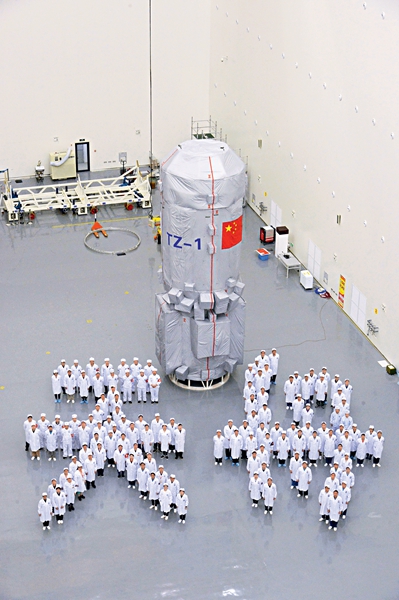Heads in the stars
- By Li Yuan
 0 Comment(s)
0 Comment(s) Print
Print E-mail China Today, July 17, 2017
E-mail China Today, July 17, 2017
|
Bai Mingsheng,Yu Lei,Ren Liang: China’s first independently developed cargo spacecraft Tianzhou-1 was masterminded by a team of Chinese scientists of an average age of 35. Numbers of innovative projects have been fulfilled by the team led by chief designer Bai Mingsheng. [Photo/China Today] |
On April 20, 2017 the Long March-7 Y2 carrier rocket successfully launched Tianzhou-1, China's first cargo spacecraft, from Wenchang Space Launch Center on the southern island province of Hainan. Three days later, it docked with the orbiting Tiangong-2 space lab.
China independently developed the Tianzhou-1 spacecraft and its multiple, internationally advanced technologies. The project was masterminded by a team of Chinese scientists of an average age of 35. They include Bai Mingsheng, Yu Lei, and Ren Liang.
Bai Mingsheng, chief designer
Bai Mingsheng, chief designer of Tianzhou-1, studied spacecraft design and applied mechanics at Beihang University, and joined China Academy of Space Technology in 1988. He has since been involved in the development and launches of Shenzhou spacecrafts 1, 2, 3, 4, 5 and 7. In 2011 he led the team of young scientists, mostly in their 20s, which developed Tianzhou-1. That year he turned 45.
Bai returned to Beijing on April 28 after the successful launch of Tianzhou-1. Although he had not seen his family for some months he went directly to the Beijing Aerospace Control Center. He knows better than anyone that a successful launch is only the first step of a complex outer space mission. Tianzhou-1 was scheduled to carry out a number of tasks over the ensuing five months, including three dockings with the orbiting Tiangong-2 to pump propellants into the minispace station and various space experiments. Bai cannot rest until he has witnessed their successful completion.
Bai and his team have worked 10 hours or more a day for the past six years. They have painstakingly toiled over every component of the spacecraft and each step of the process leading to the launch. They consequently regard one another as family members, and the spacecraft as an offspring.
They have just cause to be proud of their progeny. Tianzhou-1 has achieved six "firsts" in China's aerospace history. It is China's first cargo spacecraft to undergo a flight test mission; and it has a six-ton carrying capacity with a 0.48 payload ratio. That makes its carrying capacity the largest of any existent cargo spacecraft in commission. The successful in-orbit refueling renders China the third country in the world, after the U.S. and Russia, to have mastered this technology. Tianzhou-1's initial use of Ethernet technology makes possible the 1Gb/s Internet connection between the Earth and outer space. It is also the first of its kind to carry out a fast, fully automated rendezvous, and has reduced the duration of this maneuver from two days to 6.5 hours. The spacecraft is moreover the first to implement various technological applications and tests in a single mission. And the mission marks China's first automatic de-orbit and destructive reentry into the Earth's atmosphere after the airship completing its service. The country has thus contributed towards a clean, safe space environment.
Seeing Tianzhou-1 blast off reminded Bai Ming-sheng of the euphoria he felt decades earlier upon passing the rigorous national college entrance exam. He ascribes this success to the excellent and conscientious work of the entire team.
Bai calls on young scientists to grasp the opportunities and meet the challenges of the era. "China's space sector has been advancing at a rate of knots over recent years, having progressed from launching a single satellite every few years to several dozen in just one. This opens up a broad scope of opportunities for young scientists. However, heavy workloads and tight time schedules necessitate young people's involvement in research projects immediately after graduation. There is a negligible time margin for any transition or preparatory work experience.
While monitoring the Tianzhou-1 mission, Chinese scientists are also preparing for the launch of Tianzhou-2 and 3. That means Bai Mingsheng and his team will carry on working at full throttle. "China is a major player in the aerospace sector, but it has some way to go before it becomes a heavyweight. Our mission is to make the country an aerospace power."







Go to Forum >>0 Comment(s)